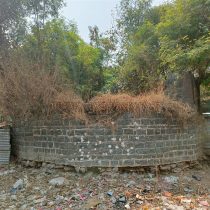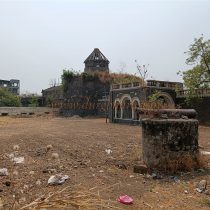AKKALKOT
TYPE : CITY FORT
DISTRICT : SOLAPUR
HEIGHT : 0
GRADE : EASY
Akkalkot Fort signifies Shri Swami Samarth Maharaj!!! Due to Swami Samarth Maharaj, Akkalkot city is famous throughout Maharashtra. Although it may be true that Akkalkot identity is incomplete without Swami Samarth Maharaj, the history of Akkalkot has taken a different turn, and this is indeed true. Akkalkot was an independent state in the eighteenth century. In 1708, Ranoji Lokhande was adopted by Chhatrapati Shahu Maharaj, and he was named Fatehsingh Bhosale. Fatehsingh Bhosale was the founder and first ruler of the Akkalkot state. Until 1848, Akkalkot and Satara were part of the same state, but after the annexation of Satara, Akkalkot gained the status of an independent state. In the eighteenth century, Akkalkot city was located within the fortifications. The entire city was surrounded by ramparts and trenches. The founder of the Akkalkot state, Fatehsingh Bhosale, had an Old Rajwada, which was a kind of ground fort. To visit Akkalkot city, the most convenient place is Sholapur.
...
Sholapur is 40 km away from Akkalkot, and to reach Akkalkot from the railway station, there are buses, rickshaws, and other public transport options available. Although the ramparts of Akkalkot have now been completely destroyed, only one bastion remains. This bastion is located near the Swami Samarth Maharaj temple, and it is the starting point for the Akkalkot trek. Until 2008, there were two bastions and fortifications around them visible. However, in 2022, during the Akkalkot trek, one bastion was lost, and the transformation of the ramparts into a wall was seen, leading to a shop. This bastion is attached to the main road to the temple and the path to come out. Although the bastion is visible from the outside, due to encroachments from all four sides, the path to reach it is not easily visible. To go to this bastion, you have to take the last shop in the lane from where you go to the temple. Near to this shop there is small passage. You have to take this passage to reach this bastion. This bastion, of octagonal shape, is built in stone and has a beautiful stone carving on top. Most of the bastion is submerged in the ground, and its current height is 15 feet. Since this is the only remnant stone bastion of the fort, our trek of this Nagarkot starts and ends here. After this, the second remnant to explore is the Old Rajwada. This Rajwada is built on a high platform, and a large part of it has collapsed in the current situation. The main entrance of the Rajwada is facing east, and above the door is the municipal office. The four bastions of the fort are still intact, and on the left side of the door is a stone carving resembling a tiger. The upper part of the Rajwada has collapsed to a large extent, so entry is not allowed there. In the main entrance area, there is a porch where ongoing work is being carried out. This place must have been the residence of security personnel. In this porch, there is a second door to enter the inner part of the fort. There is no entry beyond this point. On the north side of the fort, there are two large cannons placed on two bastions with domes. The third structure is the new Rajwada. Here, there is a museum of the institution's historical armory, displaying a large collection of ancient weapons for visitors to see. On the previous side of the fort, two medium-sized cannons can still be seen. While exploring Akkalkot city, many old houses and forts, as well as wada (large houses), can be seen. Starting early in the morning, it takes half a day to explore the city, and in the second session, one can visit the Sholapur Fort. While wandering through the fortifications of Akkalkot, a visit to the Swami Samarth Maharaj Math, paying respects and seeking blessings, adds a sacred touch to the journey. In 1689, after the fall of Raigad, Queen Yesubai and son Balshivaji (Shahu Maharaj) became prisoners of the Mughals. In 1707, after Aurangzeb's death, Azam, who became the ruler, kept them in house arrest near Bhopal. Shahu Maharaj, while coming to the south, had a small battle with Shahuji Lokhande-Patil near Parado resulting in the death of the village's Patil. At that time, his widow requested protection by placing her son Ranoji Lokhande on Shahu Maharaja’s feet. After Shahu Maharaj accepted him as an adopted son, he gave him the name Fattesing to maintain the family lineage. This boy, in other words, Fattesinghraje Bhosale, became the founder of the Akkalkot. Fattesing Bhosale was recognized as the son of Shahu Maharaj. Due to this, he was given the Subha of Karnataka by Shahu Maharaj. In 1725, to stop Nizam from attacking, Fattesing Bhosale was sent on a military expedition to Karnataka. While on the way to military expedition he had a rule that the representatives and chief should stay with him. Shahu Maharaj had made this arrangement to ensure the cooperation of Peshwa in state affairs. Shahu Maharaj, to maintain the prestige of the prince, gave Fattesing Bhosale a proper arrangement. After conquering all the territories from Chitradurga to Saunde Bidnoor until 1725-26, Fattesing Bhosale came to Satara and received the honor from Shahu Maharaj. Shivaji Maharaj's throne at Raigad was under Mughal control. He again sent him to take back this place in Maratha control state. The campaign continued from 1731 to 1734, and Raigad came back under Maratha control. After the death of Chhatrapati Shahu Maharaj, Fattesing Bhosale permanently settled in Akkalkot. He kept himself away from the affairs of the Peshwa. After the death of Fattesing Bhosale on November 20, 1760, in Akkalkot, a conflict arose among his sons, resulting in the emergence of three branches, namely Akkalkot, Piliv, and Rajache Kurle. Rajache Kurle and Piliv are the fortresses of Raje-Bhosale in these two places, the main institutional heads are: 1. 1707-1760: Fattesinghraje Bhosale 2.1760-1789: Shahuji (Babasaheb) Bhosale 3. 1789-1822: Second Fattesing (Appasaheb) Bhosale 4. 1822-23: Maloji (Babasaheb) Bhosale 5.1823-1857: Second Shivaji (Appasaheb) Bhosale 6. 1857-1870: Second Maloji (Bubasaheb) Bhosale 7. 1870-1896: Third Shivaji (Babasaheb) Bhosale 8. 1895-1923: Captain Fattesing (Third) Bhosale 9.1923-1952: Vijaysinghrao Bhosale 10.1952-1965: Jaysinghrao Bhosale.
After India gained independence in 1947, Akkalkot merged with India in the following year.
© Suresh Nimbalkar

























